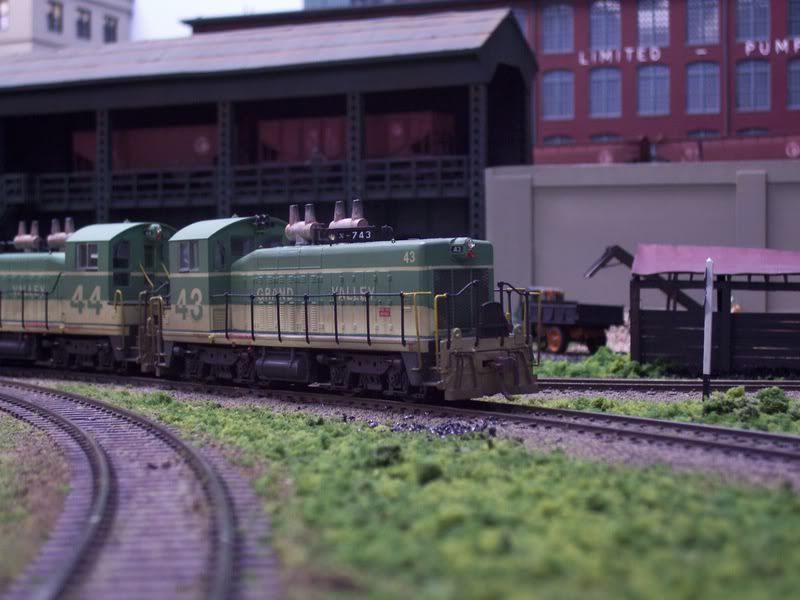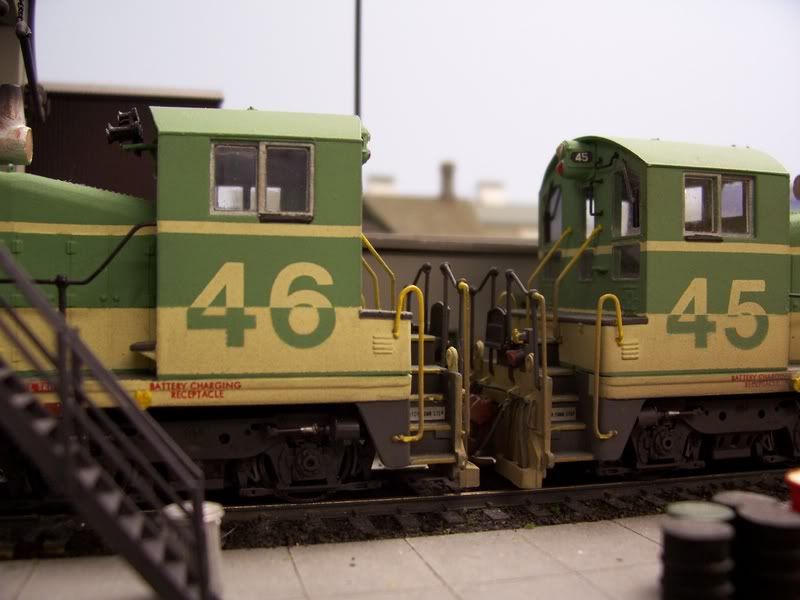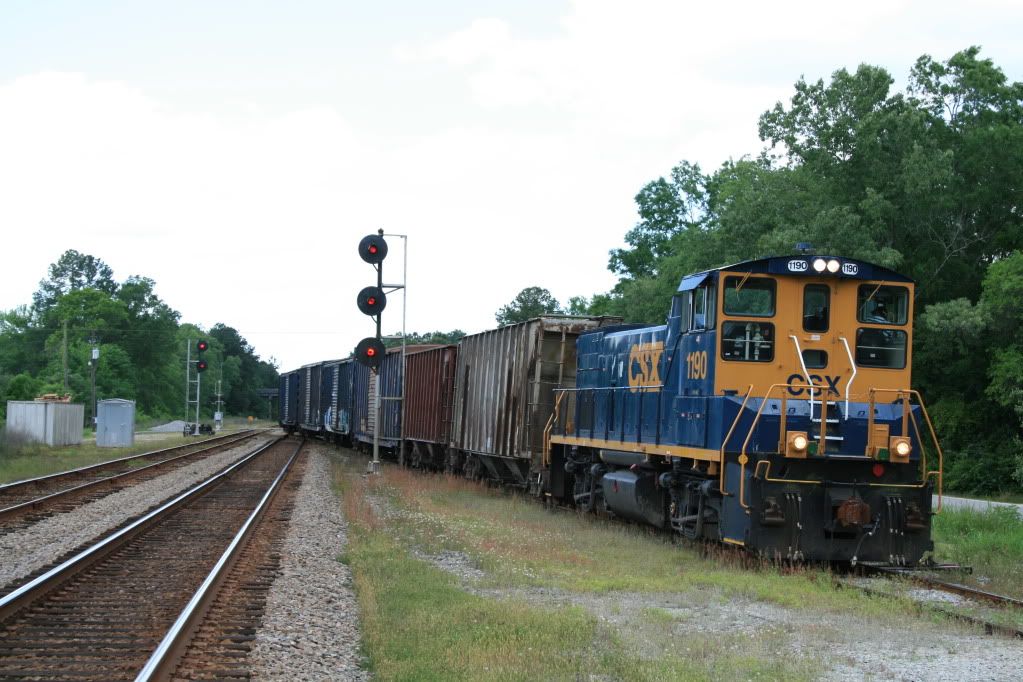I have read about and seen pictures of SW 1500s, SW 1000s, and MP15s and a few others used for light road service. My question is this: Were SW-7’s ever used for light road use, primarily for 3-4 car runs (yard to yard, quick )? If they were, I’d imagine the prototype would be equipped with Flexicoil trucks and would be limited to 40-45 mph among other items (based on what I have read about other switchers used for road service). Any assistance that anyone can provide would be welcomed.
If I recall correctly, the MP15 was designed to work with road engines. I thought I read somewhere that the SW 1500 could be built with optional equipment for road service. And if my memory is correct, most earlier switchers were really not good for any but the lightest road duty.
I have a hard time imagining the large railroads moving only 3-4 cars between yards. I would think in most cases, those movements would involve much larger numbers of cars, and such runs would be powered by road switchers. And even if the AB&C only had 3-4 cars for the D&EF, that train might have to pick up a much larger cut of cars for the return trip.
Another issue with switchers is whether a particular unit was equipped with a toilet. Some union agreements and government regulations required that road engines be equipped with a toilet.
What I had in mind was runs of cars that don’t require a full road engine, like a GP-20 (example, my road’s primary motive power) but would use two SW-7s. Another example would be a low priority move that couldn’t tie up primary power due to limited resources (short line or a regional railroad). I was only using the small number as an pike size example or maybe modeling the end of a run. There is also another selfish reason why I was wondering about the use of SW7s. I have an abundance of SW7’s that could be used. I use custom decals for my lettering. I am unable to get more decals due to the production method (ALPS printer & silver ink), hence I am unable to letter another locomotive. (Besides which, I really don’t need or want another locomotive.)
i don’t know much about what other roads did but on the old NYC the East Alton Transfer that worked between East Alton Illinois and Michell used an early EMD SW-something or other.
NCB-1/CBN-2 which operated as a local between E. St. Louis and Mitchell used a little SW-1. Best I can recall, it was the 8491.
the locals that worked longer runs, for instance the Mattoon/Hillsboro turn used an older high nose Geep while the Old Line local between Hillsboro and Mitchell used another high nose Geep that functioned as the Hillsboro yard job during the day and the local engine at night.
friction bearing trucks seemed to be the deal breaker none of these engines were turned at either end of their runs and I believe the Geeps were equipped with dual controls but that has been over 40 years ago so I may be wrong about that. another reason that yard engines might be restricted from this type of service would be lack of cab signals and/or ats.
grizlump
Use as a local was what I had in mind. And also to add variety to the operation. (I am someone who doesn’t like unit trains. I find them rather boring. I really love mixed freights.) I was planning to equip them with Flexicoil sideframes in order to have it with road trucks.
EMD Switchers and Transfer Locomotives. The Transfer Locomotives were basically two unit cow-calf versions of the switchers.
Sure. The Lehigh Valley had a series of SW8’s equipped with dynamic brakes and MU that were used as road units on light rail coal branches. They would operate in consists of 3 or 4 and handle coal trains up to the mines and back.
Search for “Lehigh Valley Railroad Pups” to find lots of pictures and descriptions.
The Minneapolis Northfield and Southern Railway’s “hgh line” that I grew up watching primarily used switchers on freight trains. Of course, their train’s top speed was usually around 15-20 MPH. Except for a big Baldwin DRS 6-6-1500, the high line usually featured a FM H-10-44 or H-12-44, or a Baldwin VO-1000 on trains into the mid-sixties.
Between 1962-1966 the road bought six SW-1200 and two SW-1500 switchers. They took over the high line from the late sixties til the Soo Line takeover in the eighties. Normally two switchers would run back-to-back, since the high line was a dead end branch line with a runaround track and no turning facilities. On the mainline, sometimes the road would have four SW’s m.u.ed together on a train.
AFAIK none of the switchers had anything other than normal ‘switcher’ type trucks.
When I was a kid the Chicago & North Western used an SW type switcher, probably an SW7, for the local. It would bring down cars from the yard, switch the various industries on the eastbound track, head south to an intermediate yard where it would drop off some cars and possibly pick others up, and then return switching on the west bound track (almost every turnout was training point switch). This was a full day’s work and they might have put 50 or more miles on the engine. As for toilets, they had a caboose of course, and almost all the old depots were still open either with operators or were used by track gangs.
Although they were running on a high speed line used by passenger trains there were long gaps between trains once the day got going, and there were plenty of sidings to get the train off the main if they needed to.
Some days they’d be hauling 20 or more cars.
By the 1970s you were more likely to see a GP7 in that service - and there were fewer industries to switch too.
Dave Nelson
Yes,a EMD (or any brand) switcher could work a light branch line as well…
PRR used 2 Baldwin switchers out of Lancaster(Oh) in the early 60s.These was replaced with SW1200s.
Hi!
I recall SW switchers used for movements on the C&NW on the northwest side of Chicago when I was a kid. My guess is that it was done on other roads as well - if the loco fit the need.
The thing is, I seriously doubt that there is anything of that nature that we can say was never done. Given the number of RRs and the service time of those switchers, I would say anything was possible.
Those MN&S SW1200 & SW1500 engines were equiped with MU & Flexicoil road trucks. They many times were run in 4 unit sets on ‘Road Trains’ to Northfield and Randolph. The MP15AC has a chemical toilet in the car body(just ahead of the cab). The electrical panel is in a ‘cube’ located in the cab area(at least on the MILW units).
Jim
One of my books has a clear picture of the CB&Q using a SW on a local run along the Aurora/Chicago main line (from the late 50’s most likely). That has to have been their busiest line. Some smaller coal and industrial lines would use gangs of SW’s, with the standard truck, to pull full length freights. I’m at work or I would have a more specific reply.
Both the CNR and CPR rostered quite a few SW1200RS units, basically an SW1200 with Flexicoil trucks. They may have been geared differently than the switcher version, too.
I built four for my free-lanced road, using the old Athearn SW7 switcher (mislabelled as an SW1500). Remotored, they pulled well and also ran well with my Athearn and Bachmann steamers.


This SW9 is a true switcher, seen here several miles from her home territory of Hamilton, Ontario. She’s acting as a head-end helper here, assisting a joint CPR/TH&B/Conrail freight up the Niagara Escarpment and is not mu’ed with the accompanying units.

Wayne
Great Northern had SW7s with Flexicoil trucks.
Many railroads rostered switcher only fleets.The Indiana Harbor Belt, B&O Chicago Terminal, Montour, Ironton, and the Kentucky & Indiana Terminal were a few. The NYO&W rand many road freights with NW2s.
Here’s a photo of a CSX MP15AC being used in local service at Hardeeville, South Carolina. This photo is from April 28, 2009. I expect that there are times that that dispatcher appreciates that the MP15 can make some level of speed when out on the double-track main.

Another instance comes to mind of switchers being used for distance runs. The C&NW had a line running out to Freeport, Illinois. The trestles along the Pecatonica River were not in the best condition, so the axle loading of a locomotive was a concern. The C&NW ran trains powered by SW1s out from Rockford (about 25 miles). Sometimes there would be as many as 4 or 5 SW1s mu-ed. That was in the late 1960’s - very early 1970’s.
Bill
It wasn’t a complete success, but Union Pacific once employed TR5 sets (cow-and-calf SW9s) as mainline helpers on the Cajon Pass and Cima Hill grades in California. This went on through most of the 1950s.
Dynamic brake systems were added to the A-units (not for their good looks!) but the switchers still were not well-suited for the job. They eventually got replaced on the mainline, by road power, and re-assigned to yard work .
i remember seeing SW and NW units in local service on Boston & Maine branchlines and sometimes on the mainline. They did, however, have a bunch of GP7s and RS3s that they would use more often on the mainline. I have movies but not many photos. One memory of my youth at Ayer, Massachusetts was seeing a switcher go by with a “buggy” (caboose) doing about 60 mph on the main! I never saw a switcher go that fast before that or since. Some railroads did MU a pair of EMD switchers for transfer service. The Wabash did that in the Toledo area.
There is a picture in one of the books on the Clinchfield of a train using an SW7, along with a GP7, and a F-unit as pushers on a train leaving Erwin, TN.